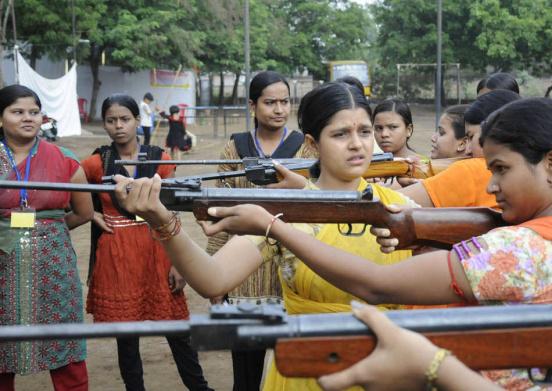New Delhi, Feb 5: The Durga Vahini or Durga brigade appeared in the early 1990s at the height of the Ram Janmabhoomi movement: its objective was to band together Hindu nationalism's female “youth.”
This organisation, like the Bajrang Dal, too, stresses defence — especially self-defence — of young Hindu women, including training in the use of firearms. It also continues the tradition started by the Rashtra Sevika Samiti, a women's organisation founded in 1936 alongside the RSS, whose primary objective was to train Hindu women in self-defence techniques to enable them to resist Muslim aggressors.
The founding chairperson of the Durga Vahini is Sadhvi Rithambara, known for her provocative speeches against Muslims. The self-advertised mission of the group is 'protection of Rashtra-Dharma and Sanskriti through… a renaissance in the Hindu society with Service, Security and Sanskars as its motto.' It was set up by the Sangh Parivar as a “moral police” to specially take up issues related to obscenity, molestation and human trafficking “to protect the womenfolk.”
In a mission statement, the outfit says its members provide “a solid support to the Hindu society and culture by ending all types of insecurity, unrighteousness, immorality and inequality among Hindus and to launch our nation on to the path of progress; to create a Dharmic atmosphere and to re-establish Dharma by destroying all the wicked and crooked people like Durga Devi did in the ancient times”.
The Durga Vahini has seen action on several occasions, starting in 1990 during the riots in Bijnor in western Uttar Pradesh: on that occasion, its activists organised a Bajrang Dal procession through the Muslim quarter of the city shouting provocative slogans that triggered the violence. Then in March 2002, Durga Vahini activists, wielding tridents and sporting saffron headbands, ransacked the Orissa Assembly, along with members of the VHP and the Bajrang Dal to protest against criticism of their members by some MLAs. In March 2004, six Durga Vahini members were arrested in Gwalior for blackening the face of Neetu Sapra, director of the play Kal Aaj Aur Kal. The VHP and the Bajrang Dal claimed that the play depicted Rama, Sita, Lakshman and Hanuman in an “indecent” way.





Comments
Add new comment